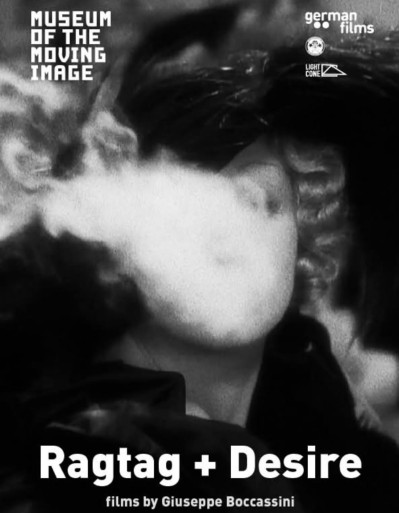Screening
Giuseppe Boccassini's "Ragtag" + "Desire"

On Sunday, July 27th, at 5pm, The Film-Makers' Cooperative will present two films recently added to our collection by new filmmaker-member Giuseppe Boccassini, RAGTAG and DESIRE, at the Museum of the Moving Image.
Giuseppe Boccassini's Ragtag (2022) and Desire (2025) will screen at the Museum of the Moving Image, co-presented by The Film-Makers' Cooperative, as part of their Special Screenings series. This program will feature a Q&A with Boccassini and film historian Tom Gunning, moderated by curator David Schwartz.
Program:
Ragtag (2022, 84 minutes) is a chronological timeline collage based on a wide corpus of footage taken from the so-called classic era of American cinema which 1950s, après la lettre, French critics labeled film noir. The decoupage-based work covers roughly twenty years, or 310 noir films, spanning from the early 1940s to the late 1950s. It also includes some foreign-made film noirs.
Noir harks back to the earlier tradition of Gothic literature, specifically the fiction of Herman Melville and Edgar Allan Poe and to the later hard-boiled literature of Dashiell Hammett, Raymond Chandler and James M. Cain. It was characterized by a dark visual style, owed primarily but not exclusively to German Expressionism which was brought to Hollywood with the influx of German émigrés during the war.
Yet, film noir is essentially a way of looking at the world, an outlook on life and human existence beyond genres, as contextually applicable to each as an aesthetic trace, tout court. It is a compound of “Yankee ingenuity” tending to fascination with the unknown, from the first noir decade and of post-World War II atmosphere of fear and paranoia due the death of God, in a Nietzschean sense, namely the loss of insular security and meaning of things. It depicts, consequently an inversion of traditional values and the corresponding moral ambivalence, between unbridled ambition and a witch hunt, as the Red Scare, the obsession with the nuclear threat and the perpetration on an individual scale of capital punishment, intended to quell such arrears and indeterminacy. In the prerogative of crime by lust, whether individual or collective, or in contemplating its failure, de facto the noir atmosphere is found not only in crime and gangster films, thrillers, suspense and horror films but also in westerns, adventure films, melodrama, and even science fiction. It creeps into the technicolor and cinemascope film, beyond the classic black-and-white motif, engulfing its horizontal pictorial quality and landscape momentum, through a centripetal flow in a vertical axis. In working with this heritage, Ragtag deals in the presence of various techniques such as the combination of sound counterpoint and visual flicker, inasmuch as différence et répétition, tended to echo in a way the so-called Verfremdungseffekt (distancing effect), common to the broader experimental film tradition of found footage, intended as archival film, decontextualized. In doing so, the intention is not to use this footage in a documentary context or to illustrate an evidence-based narration. Rather, as an extensive historical portrait of the human psyche of the twentieth century and its dark pre and post-war landscape, the film lets the past be inscribed in a present gesture, as its own “operative field”. As an act of perpetual destruction and creation, a sort of ouroboros, a tail-devourer that roams on the threshold between history and desire, visible and invisible, light and shadow.
***
Desire (2025, 30 minutes) is a non-chronological timeline collage based on a corpus of footage from melodrama. The decoupage-based work covers roughly thirty years, from 1932 to 1958. It includes American, Argentinian, British, Finnish, Italian, Japanese, Mexican and Spanish titles.
The film follows a diachronic and synchronic path, intertwining film history over a determined period and in timeless moments. It emphasizes that although History changes in space and time, human gestures remain the same. This sense of constant repetition is a desperate way to escape the human condition, oppressed by time passing through the machinery of power. The film addresses the impossibility of total liberation from the archive - even when memory is reduced to ash - roaming at the threshold between presence and absence onto desire.
Total Run Time: 114 minutes + post-screening Q&A.
About the filmmaker:
Giuseppe Boccassini is an Italian filmmaker mainly working in Germany and Italy. He graduated in film theory at the University of Bologna and film direction at The New University of Cinema and Television, Cinecittà, Rome. His work has been shown in several international film festivals and exhibitions, including the 79th Mostra Internazionale d'Arte Cinematografica, Venice, Italy FID Marseille, France, Edinburgh International Film Festival, Scotland, Ji.hlava International Documentary Film Festival, Czech Republic, Jerusalem IFF, Torino Film Festival, Italy, IndieLisboa, Portugal, FESTACURTAS BH, Brasil, Crossroads SF, USA, Avvistamenti, Italy, Punto de Vista, Spain, Trentino History Museum, Italy, Microscope Gallery, Brooklyn, NY, Pesaro Film Festival, Italy. Light Cone Paris distributes his entire film production. By transforming and manipulating various sources of archival material, his work reflects upon the notion of proximity in contemporary media. The director considers film as "a phallic conquerer that, folding in on itself, now flaccid deus ex machina, observes itself from the inside like a lysergic membrane that slowly founders between the folds of its material." His most recent collaborations include the film editing for Aldo Tambellini's solo exhibition Black Matters at ZKM Karlsruhe, Germany, and he is the artist for Chicago Film Archives' 2018 Media Mixer. He is in charge of programming at Fracto Experimental Film Encounter held yearly at Kunsthaus Acud, in the heart of Berlin.